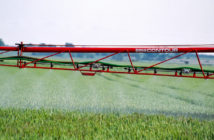Cabbage stem flea beetle attacks on oilseed rape, could be mitigated by applying silicon, two agronomists suggest.
Plants use silicon – the primary constituent of glass – as a physical barrier against attacks by pests and pathogens, laying down a hard crystal layer of ‘opals’ within the leaf cuticle.
“Two to three applications of silicon have been sufficient to reduce the feeding damage appreciably,” says Sustainable Ag Solutions agronomist Chris Coates.
Chris has been recommending silicon in place of insecticides for the last three years, after attending a farmer meeting where the idea was first floated. In early usage, Chris applied Zeme (potassium silicate) in tank-mix with an insecticide, before stripping applications back to silicon alone with no appreciable change in results.
“Applications must be made early but should be balanced against the plant presenting a big enough target. Standard cotyledon stage is ideal,” Chris suggests.
As the silicon is not a control for flea beetle, Chris says applications should be made prophylactically. “There’s been very little flea beetle damage so far this year, which I suspect is down to the wet weather having disrupted insects’ lifecycles. Now we’re monitoring flea beetle levels and will be primed to make applications if numbers rise.
“If numbers don’t rise enough to merit a separate application, then we’ll wait to tank-mix Zeme with the first herbicide application.
Effective and affordable
“At £7/ha, it’s a very affordable, very effective option for controlling this pest without recourse to insecticides.”
DJL Agriculture agronomist Dan Lievesely believes disease and pest pressures come easily to weak crops. “Besides its physical properties, silicon has a role in several plant metabolic functions. Boosting the crop’s inbuilt resilience to attack, be it from pests or pathogens, and reducing abiotic and biotic stress, has to be a more sustainable option.”
Dan has used various forms of potassium silicate over the last five years, finding it a good tool to manage not just flea beetle attack but also lodging and nutrient management.
“My recommendation centres on three applications of Zeme before Christmas,” he explains. “The first at cotyledon stage, the second at 1-2 true leaves, and the third as the last application once you’ve applied Kerb (propyzamide). We’ve avoided insecticides completely since starting to use silicon.”
Dr David Marks, co-founder of Levity Crop Science, says silicon – while rarely used as a crop input – brings considerable benefit to crop health. “Not only is it implicated in production of anti-stress hormones and antioxidants, silicon’s also vital for phosphate redistribution and trace element transport.
“It also improves crops’ nitrogen recovery abilities, especially during dry spells when soil nitrogen availability can be very low.”
Dr Marks describes Zeme, Levity’s silicon product, as potassium silicate ‘on steroids’. “Standard foliar silicon always has some effect, but because the plant quickly locks it away into opals – a one-way process – it becomes unavailable to the plant again.
“Zeme’s been formulated with naturally occurring silicon transporters that allow the silicon to move within the xylem, so the plant can actively manage absorption and distribution.
“This ensures sufficient silicon is available for metabolic functions, while allowing the plant to lay down the opals that provide the all-important pest feeding protection.
“Once in the stem and leaves, the opals confer structural strength too – which is why autumn silicon applications will last through the season to add lodging protection too.”




